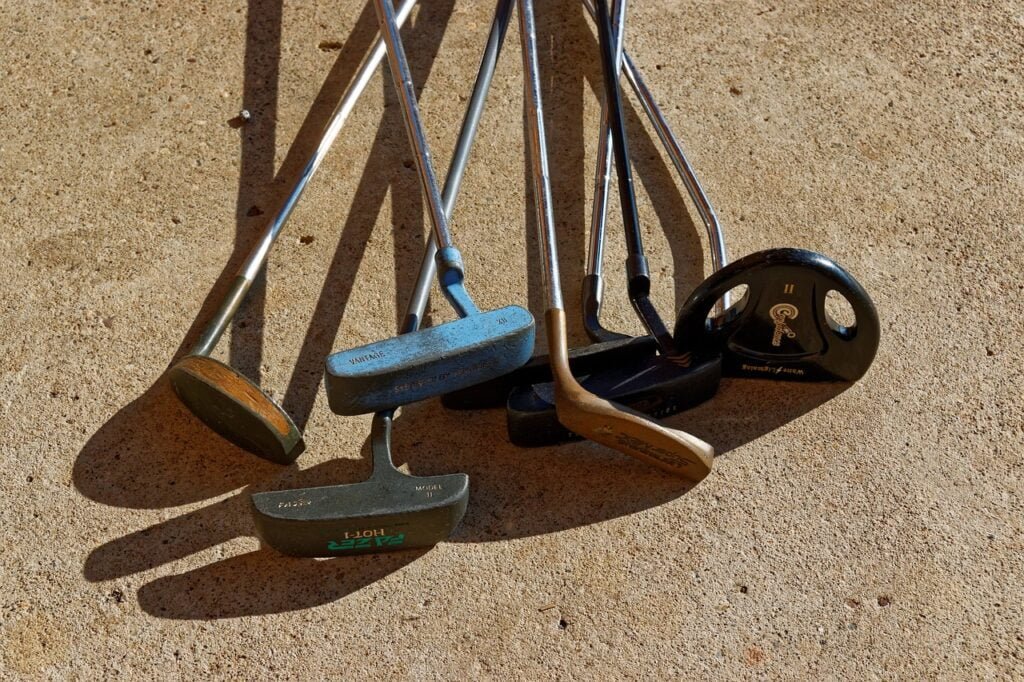Selecting the best putter can significantly impact your game, making it essential to consider various factors such as your putting stroke, preferred feel, and budget. Understanding these elements can help you make an informed decision, ensuring that your putter enhances your overall performance on the green.
Firstly, identifying your putting stroke is crucial. There are generally three types of putting strokes: straight back and through, slight arc, and strong arc. Each stroke type benefits from different putter designs. For instance, a face-balanced putter is ideal for a straight back and through stroke, while a toe-balanced putter suits a strong arc stroke. Slight arc strokes tend to work well with putters that have a moderate toe hang.
The feel is another vital aspect to consider. The material of the head, the type of grip, and the overall weight contribute to the feel. Trying out various putters with different materials and grips can help you find one that feels comfortable and enhances your confidence on the green. Some players prefer the soft feel of a milled face, while others might opt for the firm feedback of an insert putter.
Budget is also a significant consideration. Putters come in a wide range of prices, from affordable options to high-end models. It’s essential to balance your budget with your performance requirements. High-quality options often come with advanced technology and materials, but there are also cost-effective ones that deliver excellent performance.
When exploring different options, take the time to try them out on a practice green. Pay attention to how each putter influences your stroke and ball roll. Personal preference plays a significant role, as comfort and confidence can lead to better performance. Additionally, consider seeking advice from a professional fitter who can provide insights based on your specific needs and playing style.
For beginners, a mallet putter with a larger head may offer more forgiveness and alignment assistance. Intermediate players might benefit from experimenting with both mallet and blade designs to find the best fit. Advanced players often have a clear preference based on their refined skills and experience, but staying open to new innovations can also be beneficial.
The Pioneer of Heel Toe Balancing
Any discussion on the evolution of putters must commence with Karsten Solheim, a figure synonymous with innovation in the golf industry. In 1959, Solheim, leveraging his engineering expertise, introduced the Ping putter, a groundbreaking development that forever altered the landscape of golf. His most notable innovation was the concept of heel toe balancing, designed to minimize the detrimental effects of off-center hits. This breakthrough concept significantly increased the precision and consistency of putting, thereby enhancing the overall performance of golfers.
The adoption of Solheim’s heel toe balancing innovation was initially gradual, gaining traction first among lady golf professionals. These early adopters experienced improved accuracy and control, fueling interest and credibility for Ping. As the benefits became more evident, the innovation transcended gender barriers and was embraced on the men’s PGA tour. This marked a pivotal moment, establishing Solheim’s design as a staple in professional golf.
Karsten Solheim’s influence extended beyond putters, impacting the design philosophy of all golf clubs. His engineering-driven approach emphasized precision, performance, and user-centric design, setting new standards in the industry. Solheim’s contributions have not only enhanced the equipment used by golfers but have also inspired continuous innovation and improvement in golf technologies. His legacy in golf club design remains a testament to the profound impact of engineering ingenuity in sports.
The Legacy of the Ping Putter
Karsten Manufacturing, the brainchild of Karsten Solheim, has left an indelible mark on the golfing community with its iconic Ping putters. Among the treasures housed in their famed ‘gold vault’ are Ping putters that have triumphed in professional golf tournaments globally. The most celebrated of them all is undoubtedly ‘The Anser,’ a model that has continuously evolved to meet the demands of modern golf. Over the years, The Anser has seen numerous iterations, including milled versions designed to enhance the feel and minimize skid during putting.
Ping putters are meticulously engineered to incorporate specific loft angles that initiate roll almost immediately upon contact with the ball. This precision helps golfers achieve a smoother, more consistent stroke. Another standout feature of Ping putters is their heel-toe balancing, which maximizes the sweet spot on the putter face. This design minimizes distance loss on off-center hits, providing golfers with increased forgiveness and accuracy.
The diversity in Ping’s designs caters to a wide array of golfer preferences. From classic blades to more forgiving mallets, Ping ensures that there is a suitable option for every putting style. Furthermore, they offer both toe hang and face-balanced options, accommodating various putting paths and strokes. This adaptability has made Ping a preferred choice among golfers of all skill levels, further solidifying Karsten Solheim’s legacy in the world of golf.
The continuous innovation and meticulous craftsmanship behind Ping putters reflect Karsten Solheim’s enduring influence on the sport. Whether you are a competitive golfer or an enthusiastic amateur, the legacy of Ping remains a testament to the blend of tradition and modern innovation in the game of golf.
Scotty Cameron: Premium Performance
Scotty Cameron putters have carved out a distinct niche in the world of golf, renowned for their exceptional quality and premium performance. Commanding a starting price of over $400, they are not just instruments; they are a statement of precision, craftsmanship, and a deep understanding of the game. Favored by both professionals and top amateur players, Scotty Cameron putters continue to set benchmarks in the golfing community.
The design principles of Scotty Cameron putters are deeply rooted in the pioneering concepts introduced by Ping. One can observe a strong resemblance to the milled face blade design of the iconic Ping Anser. This design ensures a smooth, consistent roll and unparalleled feedback, essential for those crucial putts. The meticulous milling process not only enhances the aesthetic appeal but also ensures a flawless, consistent striking surface, a hallmark of Scotty Cameron’s commitment to excellence.
However, Scotty Cameron’s innovation extends beyond the traditional blade design. The brand offers a diverse range of mallet putters, each engineered to optimize performance through innovative weight distribution. By strategically placing weight around the perimeter, from front to back and toe to heel, these putters achieve a balanced, stable stroke. This thoughtful distribution minimizes torque and maximizes the moment of inertia (MOI), providing golfers with a more forgiving and accurate experience, especially on off-center hits.
Scotty Cameron’s relentless pursuit of perfection is evident in every aspect of their putters—from the choice of materials to the intricate design and finishing touches. Each unit is a testament to the brand’s dedication to pushing the boundaries of performance and design. For those seeking a putter that combines superior craftsmanship with cutting-edge innovation, Scotty Cameron remains a top choice, embodying the essence of premium performance in the world of golf.
Odyssey: PGA Tour Favorites
Odyssey putters have long been a staple on the PGA tour, with numerous professionals opting for these high-performance clubs. Among the standout models, the Jailbird has recently garnered significant attention. Wyndham Clark’s victory at the 2023 US Open was a pivotal moment for the Jailbird because he wielded it to clinch the title. This success was, in part, inspired by Rickie Fowler’s resurgence, using the same model, further solidifying the Jailbird’s reputation in the golfing community.
Odyssey confidently asserts its position as the number one putter on tour. However, it’s important to note that player preferences can vary widely, influenced by personal feel, stroke style, and performance under pressure. Despite this variability, the consistent presence of Odyssey putters in the bags of top players speaks volumes about their quality and reliability.
The brand’s commitment to innovation is evident in their latest offerings, notably the three different AI series putters. These putters leverage advanced artificial intelligence in their design and construction, pushing the boundaries of what is possible in terms of precision and performance. The AI integration allows for the creation of clubs that are finely tuned to provide optimal balance, weight distribution, and alignment aids, which are crucial for consistent putting performance.
Incorporating AI technology represents a significant leap forward in putter design, aiming to enhance every golfer’s ability to read greens effectively and make more accurate putts. Odyssey’s blend of traditional craftsmanship with cutting-edge technology has ensured that they remain one of the top choices among both seasoned professionals and avid golfers alike.
TaylorMade: The Rise of the Spider Series
The TaylorMade Spider Series has rapidly ascended to prominence within the golfing community, capturing the attention of both professional players and amateur enthusiasts. The series’ remarkable ascent can be attributed to its innovative design features, which have distinguished it from traditional models. Central to the Spider Series’ acclaim is its unique weight distribution, which provides enhanced stability and consistency during putts.
One of the key elements that set the Spider Series apart is its multi-material construction. By combining lightweight aluminum with heavy steel, TaylorMade has engineered a putter that offers optimal weight distribution, pinpoint balance, and reduced twisting on off-center hits. This sophisticated design minimizes the chances of misalignment, thereby ensuring a more reliable and accurate stroke.
Furthermore, the Spider Series is equipped with advanced stability-enhancing technologies. The incorporation of TaylorMade’s Pure Roll insert, which features 45-degree grooves, helps to promote a smoother roll and better forward spin. This results in improved control and distance accuracy, allowing players to execute their putts with greater confidence. Additionally, the high-MOI (Moment of Inertia) design of the Spider Series significantly reduces the impact of mishits, maintaining the clubface’s orientation and ensuring the ball stays on its intended line.
The growing presence of the Spider Series on professional tours is a testament to its exceptional performance. Many top players have opted for them, recognizing the advantages they offer in terms of stability and precision. This visibility has, in turn, spurred interest among amateur golfers, who seek to emulate the success of their professional counterparts. As a result, the Spider Series has become a popular choice among a wide range of golfing enthusiasts, further solidifying its reputation in the market.
In conclusion, the TaylorMade Spider Series stands out due to its innovative design and cutting-edge technologies. Its rise in popularity is a reflection of its ability to deliver consistent, accurate, and stable performance, making it a valuable asset for golfers at all levels of play.

Comparing Different Putter Types: Blades vs. Mallets
When it comes to choosing the right putter, golfers often find themselves at a crossroads between blade putters and mallet putters. Each type offers distinct advantages and disadvantages, which can significantly influence a golfer’s performance on the green. Understanding these differences is crucial for making an informed decision that complements one’s playing style.
Blade putters are traditionally favored for their classic design and precision. Characterized by a slim, compact head, blade putters offer a clean look that appeals to purists of the game. The primary advantage of a blade putter lies in its feel and control. The design allows skilled players to have enhanced feedback from the putter face, making it easier to judge the speed and line of their putts. However, the downside to blade putters is their lower forgiveness compared to mallet putters. Mis-hits can lead to less accurate putts, which can be challenging for beginners or those with inconsistent putting strokes.
In contrast, mallet putters feature a larger, more elaborate head design. This design not only enhances the aesthetic appeal but also improves the moment of inertia (MOI). Higher MOI means that mallet putters are more forgiving on off-center hits, making them an excellent choice for players seeking consistency. The weight distribution in mallet putters also aids in maintaining a stable stroke, which can be particularly beneficial for golfers who struggle with alignment and distance control. On the flip side, some golfers might find mallet putters to be bulkier and less maneuverable compared to their blade counterparts.
Ultimately, the choice between blade and mallet putters boils down to personal preference and playing style. Golfers who prioritize feel and precision might lean towards blade putters, while those seeking forgiveness and stability might find mallet putters more suited to their game. Testing both types and understanding how each design impacts performance can help golfers make a decision that will enhance their experience on the greens.
The Science of Putter Design: Loft, Balance, and Feel
In the intricate world of golf, putter design is a critical aspect that significantly influences a player’s performance on the green. Understanding the science behind the designs can help golfers make informed choices to enhance their game. Key elements such as loft, balance, and feel are meticulously optimized by leading manufacturers like Ping, Scotty Cameron, Odyssey, and TaylorMade to create clubs that offer exceptional performance.
The loft refers to the angle of the clubface relative to the ground. This element is crucial as it affects the initial launch of the ball and how it rolls on the green. Too much loft can cause the ball to bounce upon impact, while too little loft might lead to the ball skidding. Manufacturers like Ping and Odyssey have fine-tuned the loft angles in their putter designs to ensure a smooth, consistent roll, helping golfers achieve better accuracy and distance control.
Balance in the design pertains to the distribution of weight across the putter head. The two main types of balance are face-balanced and toe-hang. Face-balanced putters are designed to remain level when the shaft is balanced on a finger, making them ideal for golfers with a straight-back-and-through putting stroke. In contrast, toe-hang putters, which hang at an angle, are better suited for players with an arced putting stroke. Scotty Cameron and TaylorMade offer a variety of balanced options to cater to different putting styles, enhancing the precision and control of each putt.
The feel of a putter is an amalgamation of its weight, material, and design characteristics, which collectively influence the feedback a player receives during a stroke. A putter that feels right in the hands can build confidence and improve consistency. Modern designs incorporate advanced materials and technology, such as multi-material construction and face inserts, to enhance the tactile experience. Brands like Odyssey and Scotty Cameron are known for their attention to detail in creating putters that provide superior feel, ensuring golfers can trust their equipment under pressure.
Incorporating these scientific principles into designs has allowed manufacturers to create equipment that not only meets the technical demands of the game but also aligns with the personal preferences of golfers. The continuous innovation in loft, balance, and feel demonstrates the dedication of brands like Ping, Scotty Cameron, Odyssey, and TaylorMade to advancing the art and science of putting.
In summary, choosing the right putter involves understanding your stroke type, prioritizing the feel, considering your budget, and testing various options. By taking these factors into account, you can make an informed decision that enhances your performance and enjoyment of the game.



